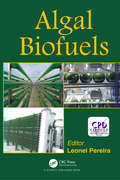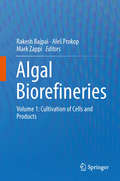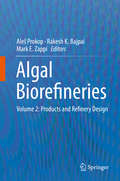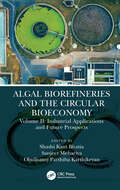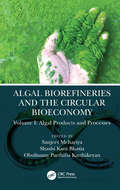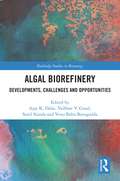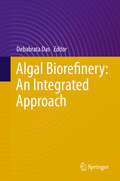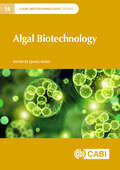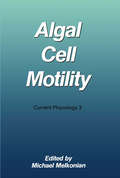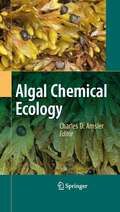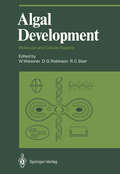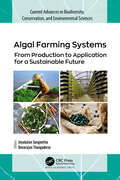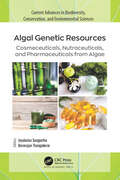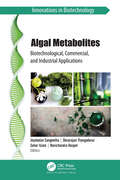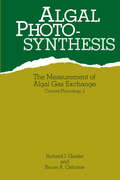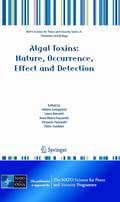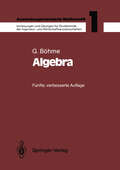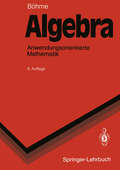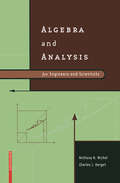- Table View
- List View
Algal Biofuels
by Leonel PereiraAlgae presents a viable biofuel alternative because the production of algae for fuel, unlike other agro-based biofuels, does not compete with food production. This book covers algae-based biofuel options and discusses the design and economic viability of algal bioenergy co-production concepts.
Algal Biofuels
by Leonel PereiraAlgae presents a viable biofuel alternative because the production of algae for fuel, unlike other agro-based biofuels, does not compete with food production. This book covers algae-based biofuel options and discusses the design and economic viability of algal bioenergy co-production concepts.
Algal Biorefineries: Volume 1: Cultivation of Cells and Products
by Rakesh Bajpai Aleš Prokop Mark ZappiThis book reviews efforts to produce chemicals and fuels from forest and plant products, agricultural residues and more. Algae can potentially capture solar energy and atmospheric CO2; the book details needed research and legislative initiatives.
Algal Biorefineries: Volume 2: Products and Refinery Design
by Aleš Prokop Rakesh K. Bajpai Mark E. ZappiAlgae offer potential to produce renewable chemicals and fuels using solar energy and carbon dioxide from atmosphere or in flue gases while simultaneously reducing the generation of greenhouse gases. Since these can be grown on marginal lands with micronutrients and macronutrients often present in waste streams, algae-based chemicals and fuels do not compete with foods. Still large-scale production of algae-based fuels and chemicals faces considerable technological and economical challenges and it would by necessity require a biorefinery approach wherein all the possible algal components are converted into value-added compounds. The present series on algal biorefineries represents a forum for reporting the state of the art of different technologies as well as the latest advances in this field. The volume II of this series complements the volume I in terms of the current state of the art. Different chapters in this volume address diverse issues ranging from genetically modifies algae to new products to life-cycle analysis of algal products.
Algal Biorefineries and the Circular Bioeconomy: Industrial Applications and Future Prospects
by Shashi Kant Bhatia"Algae are mysterious and fascinating organisms that hold great potential for discovery and biotechnology." —Dr. Thierry Tonon, Department of Biology, University of York "Science is a beautiful gift to humanity; we should not distort it." —A.P.J. Abdul Kalam In this book, we emphasise the importance of algal biotechnology as a sustainable platform to replace the conventional fossil-based economy. With this focus, Volume 2 summarizes up-to-date literature knowledge and discusses the advances in algal cultivation, genetic improvement, wastewater treatment, resource recovery, commercial operation, and technoeconomic analysis of algal biotechnology. FEATURES Discusses in detail recent developments in algae cultivation and biomass harvesting Provides an overview of genetic engineering and algal-bacteria consortia to improve productivity Presents applications of algae in the area of wastewater treatment and resource recovery Provides case studies and technoeconomic analysis to understand the algal biorefinery Shashi Kant Bhatia, PhD, is an Associate Professor in the Department of Biological Engineering, Konkuk University, Seoul, South Korea. Sanjeet Mehariya, PhD, is a Postdoctoral Researcher in the Department of Chemistry, Umeå University, Umeå, Sweden. Obulisamy Parthiba Karthikeyan, PhD, is a Research Scientist and Lecturer (Adjunct) in the Department of Civil and Environmental Engineering, South Dakota School of Mines and Technology, Rapid City, South Dakota, USA.
Algal Biorefineries and the Circular Bioeconomy: Industrial Applications and Future Prospects
by Obulisamy Parthiba Karthikeyan Sanjeet Mehariya Shashi Kant Bhatia"Algae are mysterious and fascinating organisms that hold great potential for discovery and biotechnology." —Dr. Thierry Tonon, Department of Biology, University of York "Science is a beautiful gift to humanity; we should not distort it." —A.P.J. Abdul Kalam In this book, we emphasise the importance of algal biotechnology as a sustainable platform to replace the conventional fossil-based economy. With this focus, Volume 2 summarizes up-to-date literature knowledge and discusses the advances in algal cultivation, genetic improvement, wastewater treatment, resource recovery, commercial operation, and technoeconomic analysis of algal biotechnology. FEATURES Discusses in detail recent developments in algae cultivation and biomass harvesting Provides an overview of genetic engineering and algal-bacteria consortia to improve productivity Presents applications of algae in the area of wastewater treatment and resource recovery Provides case studies and technoeconomic analysis to understand the algal biorefinery Shashi Kant Bhatia, PhD, is an Associate Professor in the Department of Biological Engineering, Konkuk University, Seoul, South Korea. Sanjeet Mehariya, PhD, is a Postdoctoral Researcher in the Department of Chemistry, Umeå University, Umeå, Sweden. Obulisamy Parthiba Karthikeyan, PhD, is a Research Scientist and Lecturer (Adjunct) in the Department of Civil and Environmental Engineering, South Dakota School of Mines and Technology, Rapid City, South Dakota, USA.
Algal Biorefineries and the Circular Bioeconomy: Algal Products and Processes
by Sanjeet Mehariya"Algae are mysterious and fascinating organisms that hold great potential for discovery and biotechnology." —Dr. Thierry Tonon, Department of Biology, University of York "Science is a beautiful gift to humanity; we should not distort it." —A.P.J. Abdul Kalam In this book, we emphasize the importance of algal biotechnology as a sustainable platform to replace the conventional fossil-based economy. With this focus, Volume 2 summarizes the up-to-date literature and knowledge and discusses the advances in algal cultivation, genetic improvement, wastewater treatment, resource recovery, commercial operation, and technoeconomic analysis of algal biotechnology. FEATURES Discusses in detail recent developments in algae cultivation and biomass harvesting Provides an overview of genetic engineering and algal-bacteria consortia to improve productivity Presents applications of algae in the area of wastewater treatment and resource recovery Provides case studies and technoeconomic analysis to understand the algal biorefinery Shashi Kant Bhatia, PhD, is an Associate Professor in the Department of Biological Engineering, Konkuk University, Seoul, South Korea. Sanjeet Mehariya, PhD, is a Postdoctoral Researcher at the Department of Chemistry, Umeå University, Umeå, Sweden. Obulisamy Parthiba Karthikeyan, PhD, is a Research Scientist and Lecturer (Adjunct) in the Department of Civil and Environmental Engineering, South Dakota School of Mines and Technology, Rapid City, South Dakota, USA.
Algal Biorefineries and the Circular Bioeconomy: Algal Products and Processes
by Sanjeet Mehariya Obulisamy Parthiba Karthikeyan Shashi Kant Bhatia"Algae are mysterious and fascinating organisms that hold great potential for discovery and biotechnology." —Dr. Thierry Tonon, Department of Biology, University of York "Science is a beautiful gift to humanity; we should not distort it." —A.P.J. Abdul Kalam In this book, we emphasize the importance of algal biotechnology as a sustainable platform to replace the conventional fossil-based economy. With this focus, Volume 2 summarizes the up-to-date literature and knowledge and discusses the advances in algal cultivation, genetic improvement, wastewater treatment, resource recovery, commercial operation, and technoeconomic analysis of algal biotechnology. FEATURES Discusses in detail recent developments in algae cultivation and biomass harvesting Provides an overview of genetic engineering and algal-bacteria consortia to improve productivity Presents applications of algae in the area of wastewater treatment and resource recovery Provides case studies and technoeconomic analysis to understand the algal biorefinery Shashi Kant Bhatia, PhD, is an Associate Professor in the Department of Biological Engineering, Konkuk University, Seoul, South Korea. Sanjeet Mehariya, PhD, is a Postdoctoral Researcher at the Department of Chemistry, Umeå University, Umeå, Sweden. Obulisamy Parthiba Karthikeyan, PhD, is a Research Scientist and Lecturer (Adjunct) in the Department of Civil and Environmental Engineering, South Dakota School of Mines and Technology, Rapid City, South Dakota, USA.
Algal Biorefinery: Developments, Challenges and Opportunities (Routledge Studies in Bioenergy)
by Ajay K. Dalai Vaibhav V. Goud Sonil Nanda Venu Babu BorugaddaThis book enables readers to understand the theoretical aspects, key steps and scientific techniques with a detailed mechanism to produce biofuels from algae. Each chapter provides the latest developments and recent advancements starting from algal cultivation techniques to the production of value-added green fuels, chemicals and products with wide applications. The volume brings together a broad range of international and interdisciplinary experts, including chemical and biological engineers, biotechnologists, process engineers, environmentalists, pharmacists and nutritionists, to one platform to explore the beneficial aspects and challenges for an algal-based biorefinery. Chapters address cutting edge issues surrounding algal cultivation, including genetic modification of algal strains, designing and optimization of photo-bioreactors and open pond systems, algal oil extraction techniques and algal-derived fuel products (biodiesel, bio-gasoline, jet-fuels and bio-oil). Finally, the book considers the potential environmental impacts for establishing a sustainable algal bio-refinery through lifecycle analysis, techno-economic assessment and supply chain management. This book will be an important resource for students, academics and professionals interested in algal cultivation, biofuels and agricultural engineering, and renewable energy and sustainable development more broadly.
Algal Biorefinery: Developments, Challenges and Opportunities (Routledge Studies in Bioenergy)
by Ajay K. Dalai Vaibhav V. Goud Sonil Nanda Venu Babu BorugaddaThis book enables readers to understand the theoretical aspects, key steps and scientific techniques with a detailed mechanism to produce biofuels from algae. Each chapter provides the latest developments and recent advancements starting from algal cultivation techniques to the production of value-added green fuels, chemicals and products with wide applications. The volume brings together a broad range of international and interdisciplinary experts, including chemical and biological engineers, biotechnologists, process engineers, environmentalists, pharmacists and nutritionists, to one platform to explore the beneficial aspects and challenges for an algal-based biorefinery. Chapters address cutting edge issues surrounding algal cultivation, including genetic modification of algal strains, designing and optimization of photo-bioreactors and open pond systems, algal oil extraction techniques and algal-derived fuel products (biodiesel, bio-gasoline, jet-fuels and bio-oil). Finally, the book considers the potential environmental impacts for establishing a sustainable algal bio-refinery through lifecycle analysis, techno-economic assessment and supply chain management. This book will be an important resource for students, academics and professionals interested in algal cultivation, biofuels and agricultural engineering, and renewable energy and sustainable development more broadly.
Algal Biorefinery: An Integrated Approach
by Debabrata DasThis book critically discusses different aspects of algal production systems and several of the drawbacks related to microalgal biomass production, namely, low biomass yield, and energy-consuming harvesting, dewatering, drying and extraction processes. These provide a background to the state-of-the-art technologies for algal cultivation, CO2 sequestration, and large-scale application of these systems.In order to tap the commercial potential of algae, a biorefinery concept has been proposed that could help to extract maximum benefits from algal biomass. This refinery concept promotes the harvesting of multiple products from the feedstock so as to make the process economically attractive. For the last few decades, algal biomass has been explored for use in various products such as fuel, agricultural crops, pigments and pharmaceuticals, as well as in bioremediation. To meet the huge demand, there has been a focus on large-scale production of algal biomass in closed or open photobioreactors. Different nutritional conditions for algal growth have been explored, such as photoautotrophic, heterotrophic, mixotrophic and oleaginous. This book is aimed at a wide audience, including undergraduates, postgraduates, academics, energy researchers, scientists in industry, energy specialists, policy makers and others who wish to understand algal biorefineries and also keep abreast of the latest developments.
Algal Biotechnology (CABI Biotechnology Series)
by Yahui Bo Gao Chen Lei Chen Zhenfan Chen Zixi Chen Pengfei Cheng Feng Ge Jiameng Guo Sanjay Gupta Xiahui Hao Qingfang He Fan Hu Hanhua Hu Krishna Kumar Jaiswal Hu Jin Vinod Kumar Anping Lei Anna I. Kurbatova Chao Li Yanhua Li Hanzhi Lin Lu-Ning Liu Qiong Liu Yandu Lu Anastasios Melis Yufang Pan Vishal Rajput Roger Ruan Shengzhou Shan Kaitlin Simmons Xiaotong Song Xinyu Song Adamu Yunusa Ugya Mikhail S. Vlaskin Chun Wang Jiangxin Wang Jin Wang Xiaojun Yan Wenxiu Yin Weiwen Zhang Xiangxiang Zhang Xu Zhang Yu-Zhong Zhang Long-Sheng Zhao Quanyu Zhao Chengxu Zhou Yali Zhu Zhu Zhen Tian Jing Cao XupengAlgae are sunlight-driven cell factories, and can efficiently absorb CO2 and convert light energy to chemical energy such as lipid, starch and other carbohydrates and release O2. Algal feedstock is a promising resource for bioproduct production, given its high photosynthetic efficiency for producing biomass compared to conventional crops. Microalgae can be used for flue-gas and wastewater bioremediation. This book highlights recent breakthroughs in the multidisciplinary areas of algal biotechnology and the chapters feature recent developments from cyanobacteria to eukaryotic algae, from theoretical biology to applied biology. It also includes the latest advancements in algal-based synthetic biology, including metabolic engineering, artificial biological system construction and green chemicals production. With contributions by leading authorities in algal biotechnology research, it is a valuable resource for graduate students and researchers in the field, and those involved in the study of photosynthesis and green-cell factories.
Algal Cell Motility (Current Phycology)
by Michael MelkonianAlgae exhibit the greatest variety of cell motility phenomena in the living world. These range from the peculiar gliding motility of filamentous blue green algae or cyanobacteria to chloroplast movements and cytoplasmic streaming which are most common in higher plants. In addition, cell motility by eukaryotic flagella is the characteristic mode of cell locomotion in algal flagellates and most reproductive cells of algae. Algae use these cell motility systems mainly to orient themselves or their photosynthetic organelles in a suitable light gradient to optimize growth and reproduction. In consequence most of the motility systems are coupled to photoreceptors and are regulated by signal transduction cascades. Algal cell motility has thus attracted consid erable interest also from non-phycologists and some algal motility systems have become models of research in cell and molecular biology. This book summarizes some of the progress that has been made in recent years in the analysis of cell motility phenomena in the algae. Although complete coverage of the subject was not attempted, the six chapters cover all the major types of cell motility systems and the authors provide in depth reviews of gliding motility, chloroplast movements, cytoplasmic streaming, flagellar beat pat terns, mechanisms of flagellar movement and centrin-mediated cell motility.
Algal Chemical Ecology
by Charles D. AmslerYet another Springer world-beater, this is the first ever book devoted to the chemical ecology of algae. It covers both marine and freshwater habitats and all types of algae, from seaweeds to phytoplankton. While the book emphasizes the ecological rather than chemical aspects of the field, it does include a unique introductory chapter that serves as a primer on algal natural products chemistry.
Algal Development: Molecular and Cellular Aspects (Proceedings in Life Sciences)
by Wolfgang Wiessner D. G. Robinson R. C. StarrProceedings of the Third Symposium on Experimental Phycology, 1986
Algal Farming Systems: From Production to Application for a Sustainable Future (Current Advances in Biodiversity, Conservation, and Environmental Sciences)
by Jeyabalan Sangeetha Devarajan ThangaduraiThe farming and cultivation of algae can provide sustainable solutions for issues like food security-related problems, costly health-related products, sustainable fuels, and more. However, the use of algae is currently restricted to high-value, low-volume markets, mainly due to the high investment and production costs involved. In recent years, algaculture for food and fuel purposes has begun a transition from R&D and pilot-scale operations to commercial-scale systems. This new book presents the latest technological innovations in algae production, market status, and prospects for algal applications.The book provides an informative overview of different perspectives on the commercial production of algae-based food, health, and high-value cosmeceutical products, providing an institutional framework to support and promote the development and commercialization of algal farming. The book discusses phycotechnology and highlights the current trends and future scope of algal technology. It also presents new information on algal culture conditions and cultivation strategies, including a look at geographic position and local climate as key factors in the implementation of microalgae-based processes. Algal production, marketing strategies, and their commercialization are discussed, as are the industrial applications of algae, focusing mainly on nutraceutical, pharmaceutical, and cosmeceutical applications of microalgae and macroalgae.
Algal Farming Systems: From Production to Application for a Sustainable Future (Current Advances in Biodiversity, Conservation, and Environmental Sciences)
The farming and cultivation of algae can provide sustainable solutions for issues like food security-related problems, costly health-related products, sustainable fuels, and more. However, the use of algae is currently restricted to high-value, low-volume markets, mainly due to the high investment and production costs involved. In recent years, algaculture for food and fuel purposes has begun a transition from R&D and pilot-scale operations to commercial-scale systems. This new book presents the latest technological innovations in algae production, market status, and prospects for algal applications.The book provides an informative overview of different perspectives on the commercial production of algae-based food, health, and high-value cosmeceutical products, providing an institutional framework to support and promote the development and commercialization of algal farming. The book discusses phycotechnology and highlights the current trends and future scope of algal technology. It also presents new information on algal culture conditions and cultivation strategies, including a look at geographic position and local climate as key factors in the implementation of microalgae-based processes. Algal production, marketing strategies, and their commercialization are discussed, as are the industrial applications of algae, focusing mainly on nutraceutical, pharmaceutical, and cosmeceutical applications of microalgae and macroalgae.
Algal Genetic Resources: Cosmeceuticals, Nutraceuticals, and Pharmaceuticals from Algae (Current Advances in Biodiversity, Conservation, and Environmental Sciences)
by Jeyabalan Sangeetha Devarajan ThangaduraiThis book focuses on the current and potential applications of microalgae and cyanobacteria in pharmaceuticals, nutraceuticals, and cosmeceuticals. The book deals with the very recent and advanced techniques and technologies in algal cultivation and extraction for its application. The chapters discuss the biological importance, properties, and uses of algal metabolites and microalgae-based compounds in drug development, in food nutrition enhancement, and in the development of cosmetics with medicinal properties. The chapter authors cover a range of diverse topics on algal biological resources, such as: algae as a nutraceutical and functional food ingredient the extraction of food bioactive compounds from microalgae spirulina-derived nutraceuticals and their applications in the food industry anticancer compounds from freshwater microalgae cosmetic applications of microalgal and cyanobacterial pigments and more This unique book, Algal Genetic Resources: Cosmeceuticals, Nutraceuticals, and Pharmaceuticals from Algae, will enlighten readers on the vast usefulness of microalgae and cyanobacteria as an important resource for the cosmeceutical, pharmaceutical and nutraceutical industries for their broad biotechnological potential industrial applications. The volume will be a valuable reference for scientists and researchers in these areas as well as for advanced students and faculty in ecology, phycology, botany, agriculture, biotechnology, microbiology, environmental biotechnology, plant science, and life sciences.
Algal Metabolites: Biotechnological, Commercial, and Industrial Applications (Innovations in Biotechnology)
by Jeyabalan Sangeetha Devarajan Thangadurai Saher Islam Ravichandra HospetAlgal secondary metabolites have several biotechnological, pharmaeceutical, industral, cosmetic, and other commercial applications. This new book highlights the recent advances in algal active metabolites, emphasizing their pharmaceutical, therapeutic, nutraceutical, and industral potential. It first provides an introduction to algal metabolites and discusses their applications. It then looks at microalgal- their pharmaeceutical, therapeutic, nutraceutical, and industrial applications. Providing a wealth of information, this book illustrates the diversity of these metabolites from indegeneous marine of freshwater sources, providing a gateway that can enable researchers and pharmaceutical companies to develop novel nontoxic, cost-effective, and highly efficient drugs.
Algal Metabolites: Biotechnological, Commercial, and Industrial Applications (Innovations in Biotechnology)
by Jeyabalan Sangeetha Devarajan Thangadurai Saher Islam Ravichandra HospetAlgal secondary metabolites have several biotechnological, pharmaeceutical, industral, cosmetic, and other commercial applications. This new book highlights the recent advances in algal active metabolites, emphasizing their pharmaceutical, therapeutic, nutraceutical, and industral potential. It first provides an introduction to algal metabolites and discusses their applications. It then looks at microalgal- their pharmaeceutical, therapeutic, nutraceutical, and industrial applications. Providing a wealth of information, this book illustrates the diversity of these metabolites from indegeneous marine of freshwater sources, providing a gateway that can enable researchers and pharmaceutical companies to develop novel nontoxic, cost-effective, and highly efficient drugs.
Algal Toxins: Nature, Occurrence, Effect and Detection (NATO Science for Peace and Security Series A: Chemistry and Biology)
by Paolo Gualtieri Valtere Evangelista Laura Barsanti Anna Maria Frassanito Vincenzo PassarelliThis volume contains the lectures and seminars given at the NATO Advanced Study Institute on “Sensor Systems for Biological Threads: The Algal Toxins Case”, held in Pisa, Italy in October, 2007. The Institute was sponsored and funded by the Scientific Affairs Division of NATO. It is my pleasant duty to thank this institution. This ASI offered updated information on how far the research on algal toxins has gone in the exploration of structures, biosynthesis and regulation of toxins, and the development of technology for bio-monitoring these c- pounds. Algae can form heavy growths in ponds, lakes, reservoirs and sl- moving rivers throughout the world; algae can house toxins which are - ually released into water when the cells rupture or die. Hundreds of toxins have been identified so far. Detection methods, including rapid screening, have been developed to help us learning more about them, especially to find out which toxins are a real threat for people and what conditions encourage their production and accumulation. Early detection of algal toxins is an - portant aspect for public safety and natural environment, and significant efforts are underway to develop effective and reliable tools that can be used for this purpose.
Algebra: Anwendungsorientierte Mathematik (Springer-Lehrbuch)
by Gert BöhmeDas mehrbändige Lehrbuch bildet - didaktisch geschickt - eine Brücke zwischen einer rein theoretischen Darstellung und der angewandten Mathematik. Das Werk ist leicht verständlich und - durch die ausgeführten Beispiele - besonders anwendungsorientiert. Es ist aus Servicevorlesungen hervorgegangen. Am Anfang dieses Kurses steht die Algebra; dieser Band hat über die klassischen Themen hinaus durch ein Kapitel Fuzzy-Algebra an Aktualität und Wert gewonnen. Die einzelnen Bände sind in sich abgeschlossen und separat einsetzbar. Sie sind also nicht nur zum Gebrauch neben Vorlesungen, sondern auch zum Selbststudium geeignet, insbesondere für Studienanfänger.
Algebra and Analysis for Engineers and Scientists
by Anthony N. Michel Charles J. HergetWritten for graduate and advanced undergraduate students in engineering and science, this classic book focuses primarily on set theory, algebra, and analysis. Useful as a course textbook, for self-study, or as a reference, the work is intended to familiarize engineering and science students with a great deal of pertinent and applicable mathematics in a rapid and efficient manner without sacrificing rigor. The book is divided into three parts: set theory, algebra, and analysis. It offers a generous number of exercises integrated into the text and features applications of algebra and analysis that have a broad appeal.
